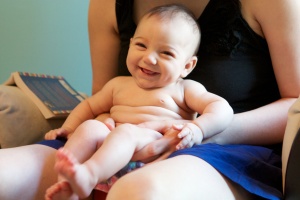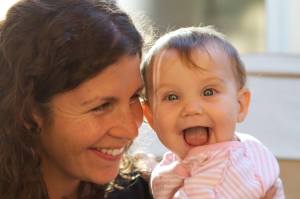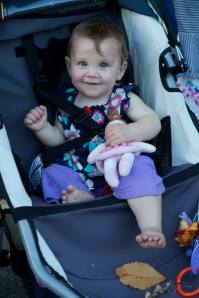
Yesterday we looked at the history of diapering/pottying in the US. Today, let’s see why we may want to take a different road…
Given our recent past, it’s easy to see why anything but a diapered baby is met with skepticism and even condemnation for parents “pushing” their children too quickly. But, as with co-sleeping, experts have failed to clarify the real issue. How you respond to your baby’s elimination needs is entirely different than when.
We don’t advocate turn-of-the-century tactics. In fact, we cringe when people comment that our little ones are “potty trained.” We aim to understand their needs, and lay the foundation for a relationship of mutual respect. We’re communicating with our babies, not training them. The difference may seem subtle (and possibly even irrelevant) before you start.
Let’s draw a firmer boundary between traditional toilet training and potty-based communication. First and foremost, with EC there’s no negativity around elimination. If your child arches his back when you put him on the potty, you’re free to let him go—even if he pees in the corner, or in his diaper a moment later. Sometimes that’s frustrating for mom, but it’s counterproductive to obsess about the miss, shame the child or use any form of punishment.
EC philosophy inherently rejects all timelines as well. Babies are individuals, so assuming they should be at a given stage is detrimental to all involved. EC is about responding to your baby’s needs—so have fun and relax. Otherwise, it’s not worth doing!
In many societies throughout the globe, babies are pottied in response to their cues. In China, for example, cotton, water, and soap are all scarce items. Mothers make a whistling sound to cue their babies, and little ones dressed in split-crotch pants easily eliminate in response. By the time children can walk, around 12-14 months, they know to squat and eliminate on their own.
In many places throughout the globe, including India, Africa, Russia, and South America, locals use a similar method. In warmer climates, babies are carried naked in slings. Mothers respond to babies’ cues and signals by taking the baby out of the sling, and little ones are free to eliminate without soiling themselves or their mamas.
So…What Now?
You want to start communicating with your little one about elimination, but you have no idea where to start. We didn’t, either. Here are four tools to launch your EC relationship.
Get going. You can potty your baby from birth, or as early as you feel comfortable. Miriam got started soon after birth; Megan waited three months until they had settled into more of a routine. It’s most important that pottying is enjoyable for everyone. If you’re overly stressed by the idea, it’s probably not the right time.
Read cues. It may seem hard to believe, but during his first few months, your little one probably communicates before he goes, whether you respond or not! Common signals include sudden fussing, squirming, grunting or crying out, becoming still, waking from sleep, or a specific facial expression.
Once your baby’s old enough to notice visual cues, you may want to incorporate the sign for potty. Around six months—or earlier, if you’d like—you can show your baby the toilet sign every time you say potty. In American Sign Language, it looks like a closed fist, shaken from side to side, with your thumb peeking out between the index and middle finger.
Once a baby begins signing, it’s pretty amazing to have him deliberately tell you that he needs to go. For some, this happens as early as nine months, but all babies develop and communicate at different rates and in different ways.
Give cues. Around the world, mothers give their babies cues, like “ssshhh” or “psssss.” In the early days of your EC journey, the cue is given when mom notices her baby going. Eventually, her baby associates the cue with relaxing his bladder and releases when he hears the sound.
Get support. In today’s wired world, if none of your neighbors practice EC, you can still get all the help and encouragement you need online. Check out The Other Baby Book’s Facebook page or Diaperfreebaby.org for more support!
**************************************************************************
This post was excerpted from The Other Baby Book: A Natural Approach to Baby’s First Year. Check out our book to learn more about other baby-friendly practices, like natural birthing, on-cue nursing, baby-led weaning, co-sleeping, and baby-wearing! And the e-version is FREE from October 9-12!!
**************************************************************************
 Megan McGrory Massaro is a mother, freelance writer, and author. She wrote The Other Baby Book: A Natural Approach to Baby’s First Year to empower women to make the best choices for their families.
Megan McGrory Massaro is a mother, freelance writer, and author. She wrote The Other Baby Book: A Natural Approach to Baby’s First Year to empower women to make the best choices for their families.
 Like many things that shaped my new parenting experience, I found out quite by accident about washing my baby’s new clothes. When my daughter was a newborn, a visiting aunt said, “You know it’s important to wash her clothes before she wears them.”
Like many things that shaped my new parenting experience, I found out quite by accident about washing my baby’s new clothes. When my daughter was a newborn, a visiting aunt said, “You know it’s important to wash her clothes before she wears them.”

![IMG_2117[1]](https://theotherbabybook.files.wordpress.com/2015/01/img_21171-e1422381443358.jpg?w=924)








